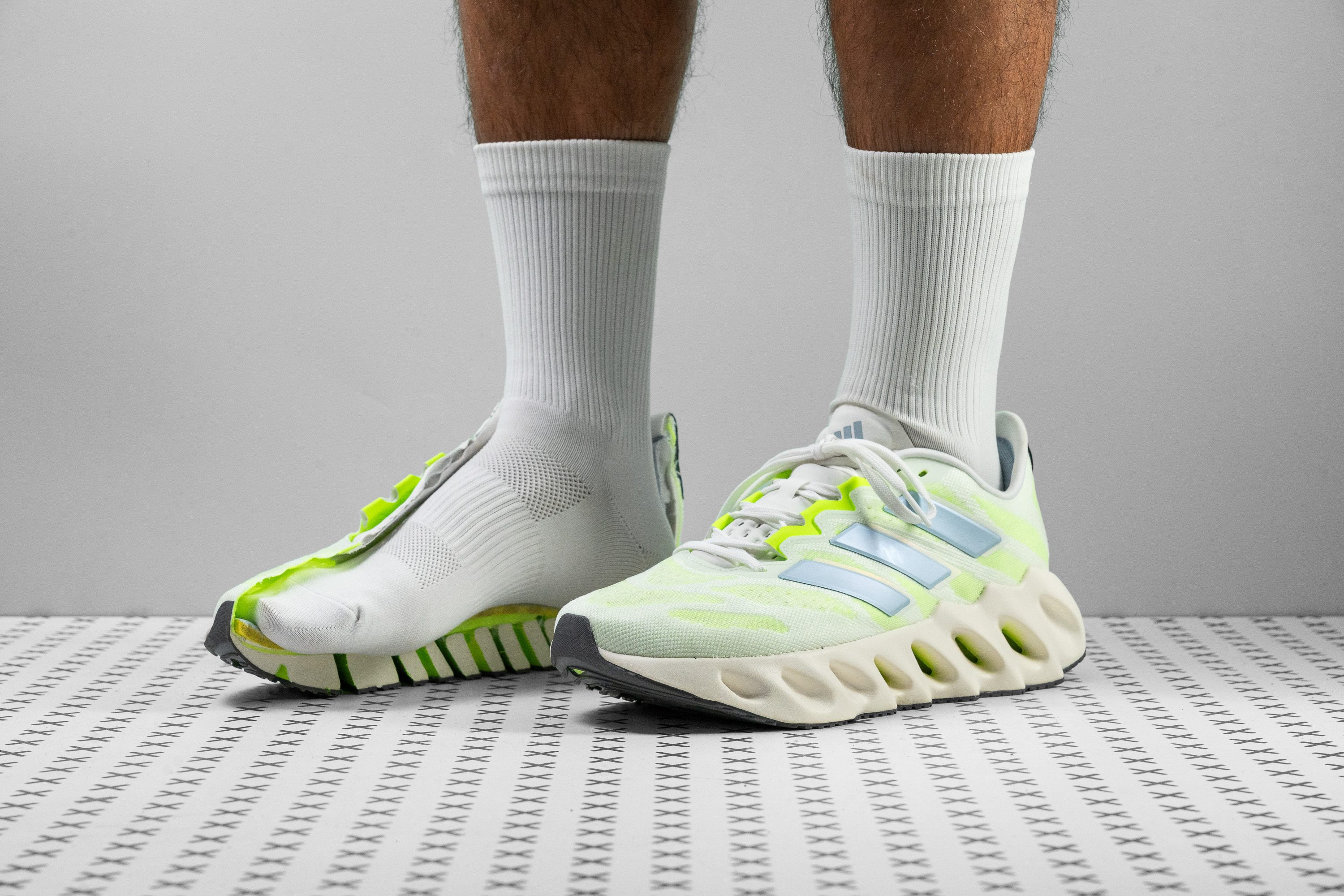Our verdict
Pros
- Head-turning design
- Great for jogs and easy runs
- Excellent as a walking shoe
- Delightful cushioning
- Nice and flexible
- Surprisingly stable ride
- Comfortable and secure heel-hold
- Above average breathability
- Durable and grippy outsole
Cons
- Quite heavy
- Not very responsive
- Not ideal for speedwork or long-distances
- Outsole voids trap debris
Audience verdict
Comparison
The most similar running shoes compared
+ + Add a shoe | |||||
|---|---|---|---|---|---|
| Audience score | 85 Good! | 89 Great! | 89 Great! | 90 Superb! | |
| Price | £120 | £160 | £150 | £170 | |
| Pace | Daily running | Daily running | Daily running | Daily running | |
| Shock absorption | - | High | Moderate | Moderate | |
| Energy return | - | Moderate | High | Moderate | |
| Traction | - | High | Moderate | High | |
| Arch support | Neutral | Neutral | Neutral | Neutral | |
| Weight lab Weight brand | 11.4 oz / 323g 11.8 oz / 334.5g | 9.9 oz / 282g 10 oz / 283g | 9.9 oz / 281g 10 oz / 284g | 10.4 oz / 296g 10.3 oz / 292g | |
| Drop lab Drop brand | 9.1 mm 10.0 mm | 8.7 mm 5.0 mm | 8.9 mm 8.0 mm | 9.1 mm 6.0 mm | |
| Strike pattern | HeelMid/forefoot | HeelMid/forefoot | HeelMid/forefoot | HeelMid/forefoot | |
| Size | True to size | True to size | True to size | True to size | |
| Midsole softness | Balanced | Soft | Balanced | Balanced | |
| Difference in midsole softness in cold | Normal | Normal | Small | Normal | |
| Toebox durability | Bad | Decent | Decent | Decent | |
| Heel padding durability | Good | Good | Bad | Good | |
| Outsole durability | Good | Good | Bad | Good | |
| Breathability | Moderate | Breathable | Moderate | Moderate | |
| Width / fit | Medium | Medium | Medium | Wide | |
| Toebox width | Medium | Narrow | Medium | Medium | |
| Stiffness | Stiff | Stiff | Moderate | Stiff | |
| Torsional rigidity | Stiff | Stiff | Stiff | Stiff | |
| Heel counter stiffness | Moderate | Stiff | Stiff | Flexible | |
| Rocker | ✗ | ✗ | ✓ | ✗ | |
| Heel lab Heel brand | 39.6 mm 45.0 mm | 39.3 mm 39.0 mm | 36.1 mm 37.0 mm | 35.3 mm 37.0 mm | |
| Forefoot lab Forefoot brand | 30.5 mm 35.0 mm | 30.6 mm 34.0 mm | 27.2 mm 29.0 mm | 26.2 mm 31.0 mm | |
| Widths available | Normal | NormalWide | Normal | Normal | |
| Orthotic friendly | ✓ | ✓ | ✓ | ✓ | |
| Season | All seasons | SummerAll seasons | All seasons | All seasons | |
| Removable insole | ✓ | ✓ | ✓ | ✓ | |
| Ranking | #430 Bottom 34% | #113 Top 31% | #90 Top 25% | #69 Top 19% | |
| Popularity | #546 Bottom 17% | #117 Top 32% | #231 Bottom 37% | #172 Top 47% |
Who should buy
We recommend the Adidas Switch FWD as a great choice to:
- Casual runners looking for a unique shoe that’s comfy enough for walks around town and the occasional easy run
- Runners who want a maximalist trainer that’s well-cushioned and stable underfoot
- Mildly pronating runners who prefer supportive a neutral shoe over a dedicated stability shoe
- Sneaker-heads who want a true attention-grabber of a shoe
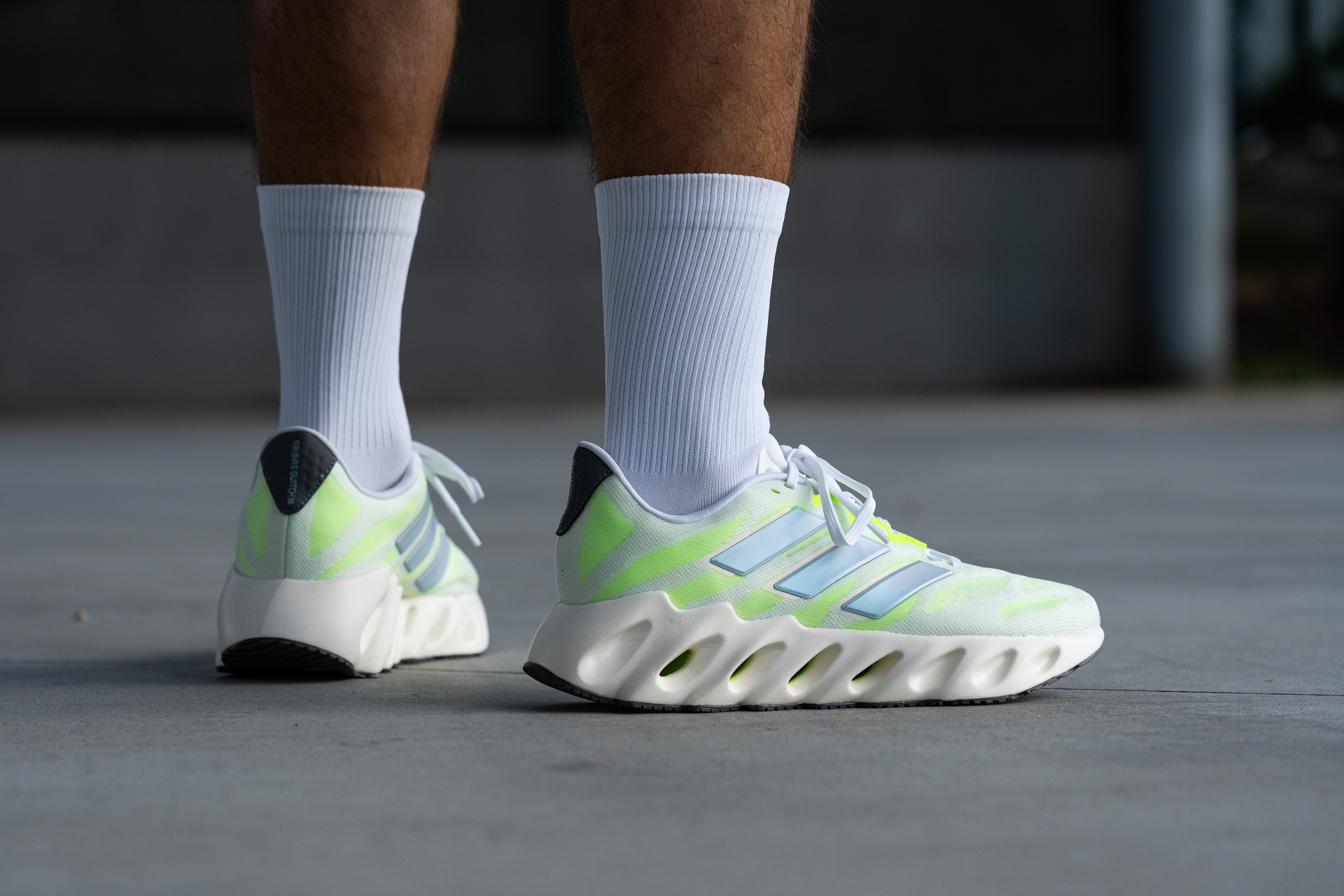
Who should NOT buy
The Switch FWD is heavy for a road shoe despite the many cutouts in the midsole and outsole. For an equally maximal shoe that's much more feathery on the scale, we recommend you check out the incredibly lightweight ASICS Superblast.
While it performs surprisingly well as a running shoe, the Switch FWD isn’t built for high-intensity or long-distance sessions. For a more versatile daily trainer that’s ready for any challenge, we recommend the Brooks Ghost 15 or the similar-looking On Cloudsurfer 7 instead.

Cushioning
Heel stack
The Switch FWD boasts a gargantuan heel stack that’s 39.5 mm thick.
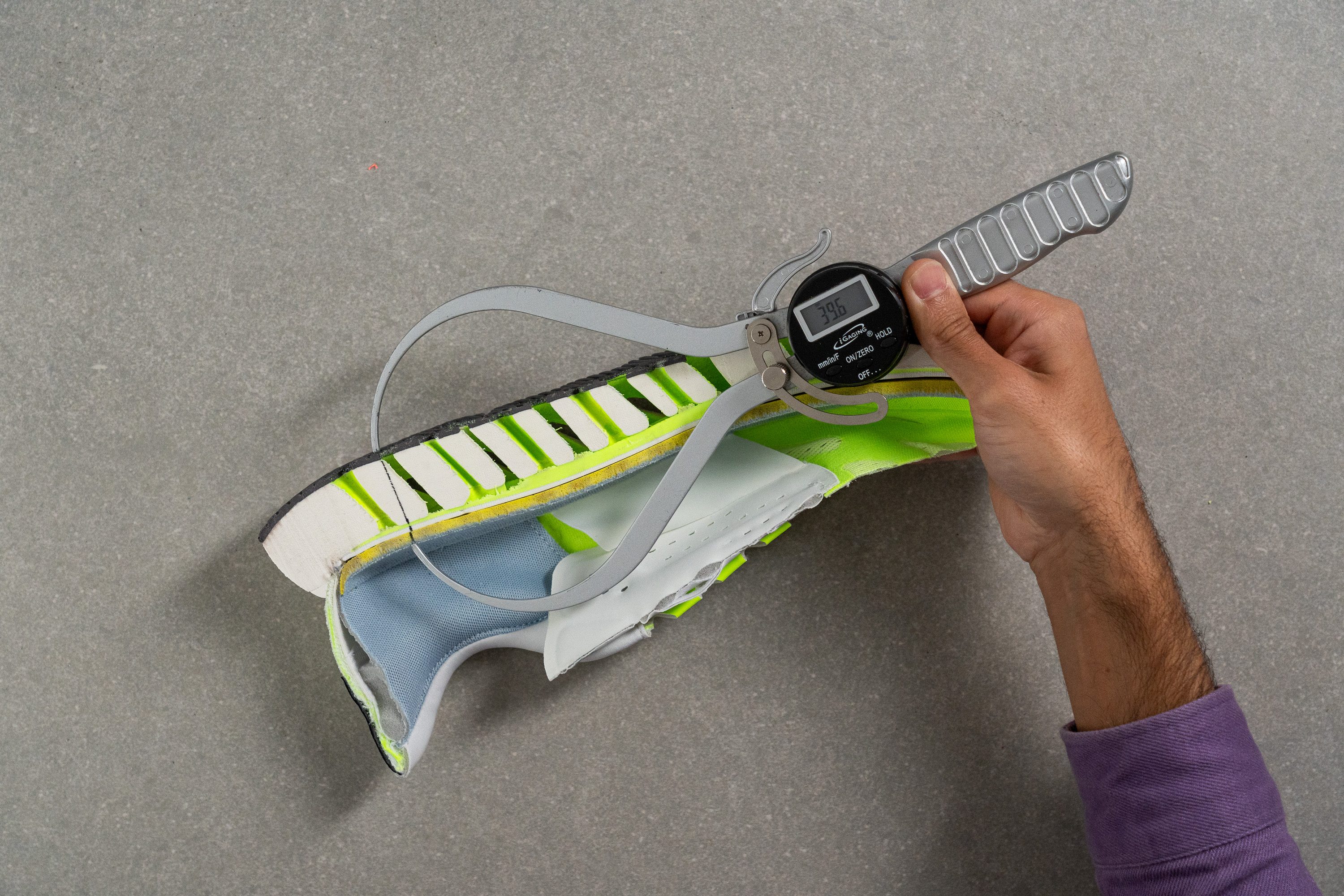
While it's not as thick as the 44.8 mm stated by Adidas, it’s still significantly more foam underfoot than found on the average road shoe, which greatly enhances our sense of perceived cushioning. As such, heel strikers will enjoy incredibly well-dampened landings that protect them from the harsh asphalt below.
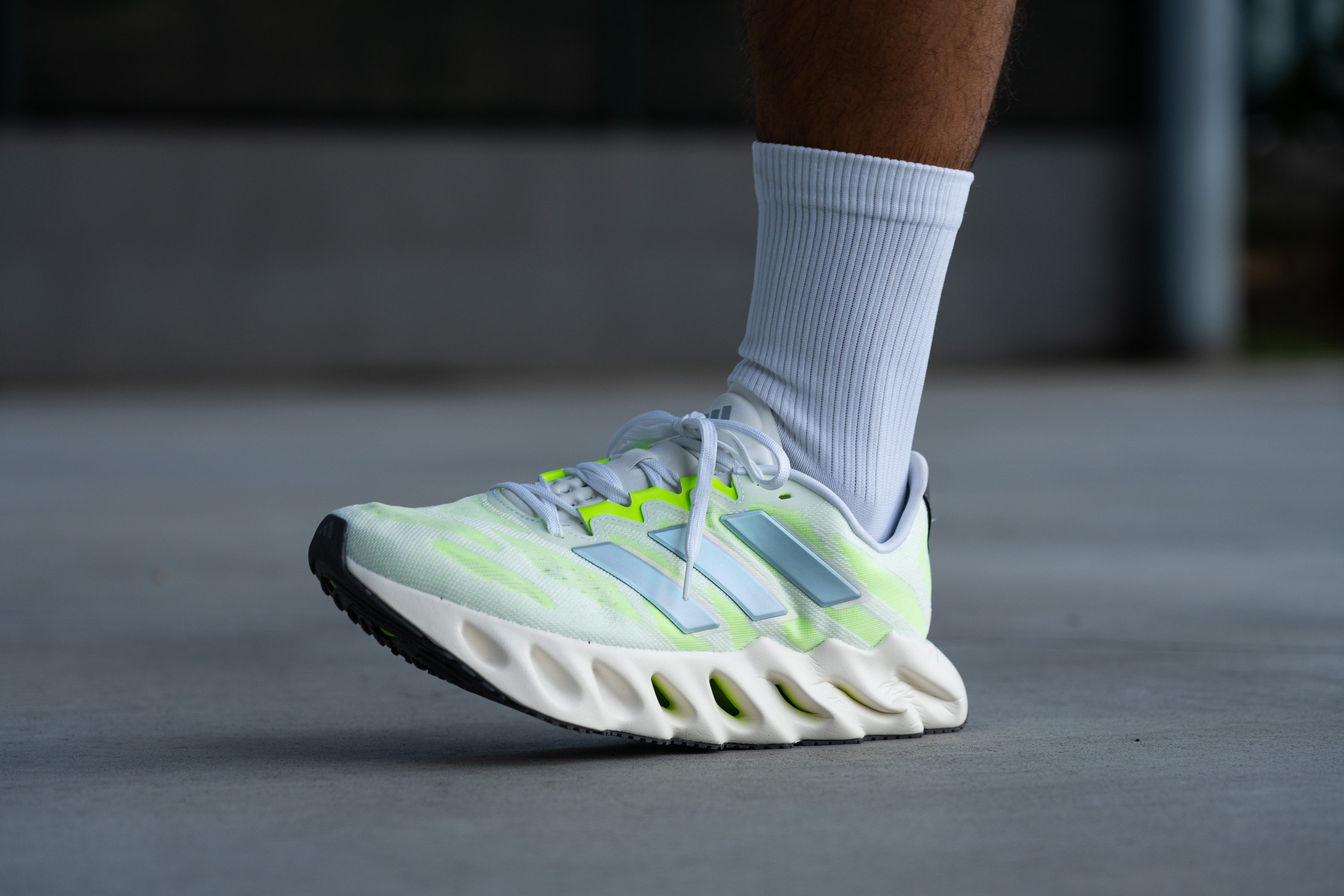
| Switch FWD | 39.6 mm |
| Average | 34.8 mm |
Forefoot stack
Despite also falling short of the spec 34.8 mm, the Switch FWD’s forefoot stack is no less robust. Measuring 30.5 mm thick according to our caliper, it towers above the average road shoe. This means that mid/forefoot striking runners also have plenty of foam underfoot to ensure protective landings in this shoe.

| Switch FWD | 30.5 mm |
| Average | 26.2 mm |
Drop
Although the stack measurements provided by Adidas are highly inaccurate, the disparity with the heel drop isn’t as drastic. The difference in our stack measurements leaves us with an actual drop height of 9.1mm versus the advertised 10 mm. This still classifies the Switch FWD as a high-drop shoe, so this difference shouldn’t be noticeable for most runners.
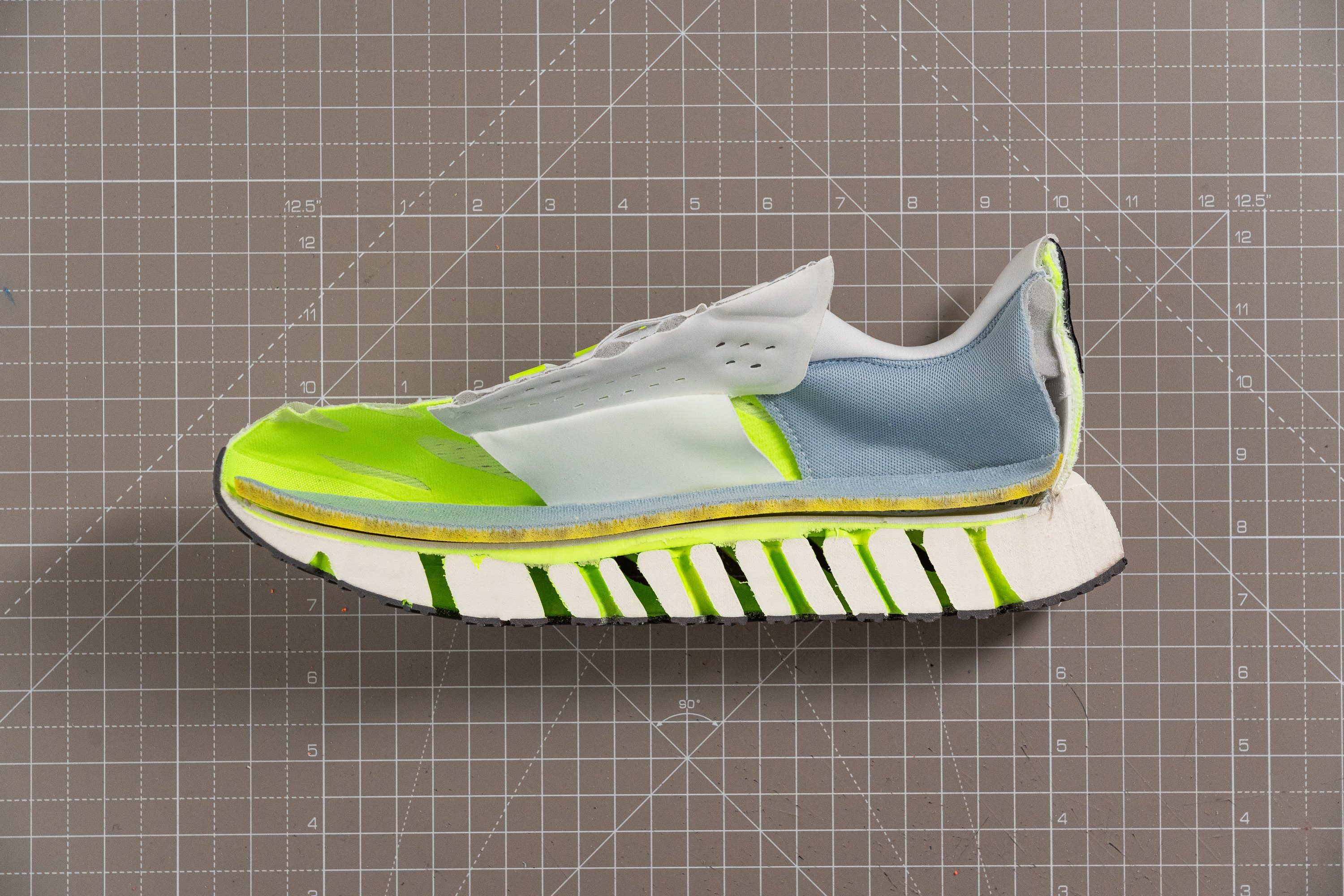
For more on the subject, this guide explains the pros and cons of different drop heights while this article explores the discrepancies between manufacturer heel drops and reality using data we’ve uncovered in the lab so far.
| Switch FWD | 9.1 mm |
| Average | 8.6 mm |
Midsole softness
Onto the star of the show, the Switch FWD’s striking midsole. Pressing our durometer against the foam, we got a reading of 27.3 HA which is quite a bit firmer than average for a road shoe. This, however, doesn’t tell the whole story.
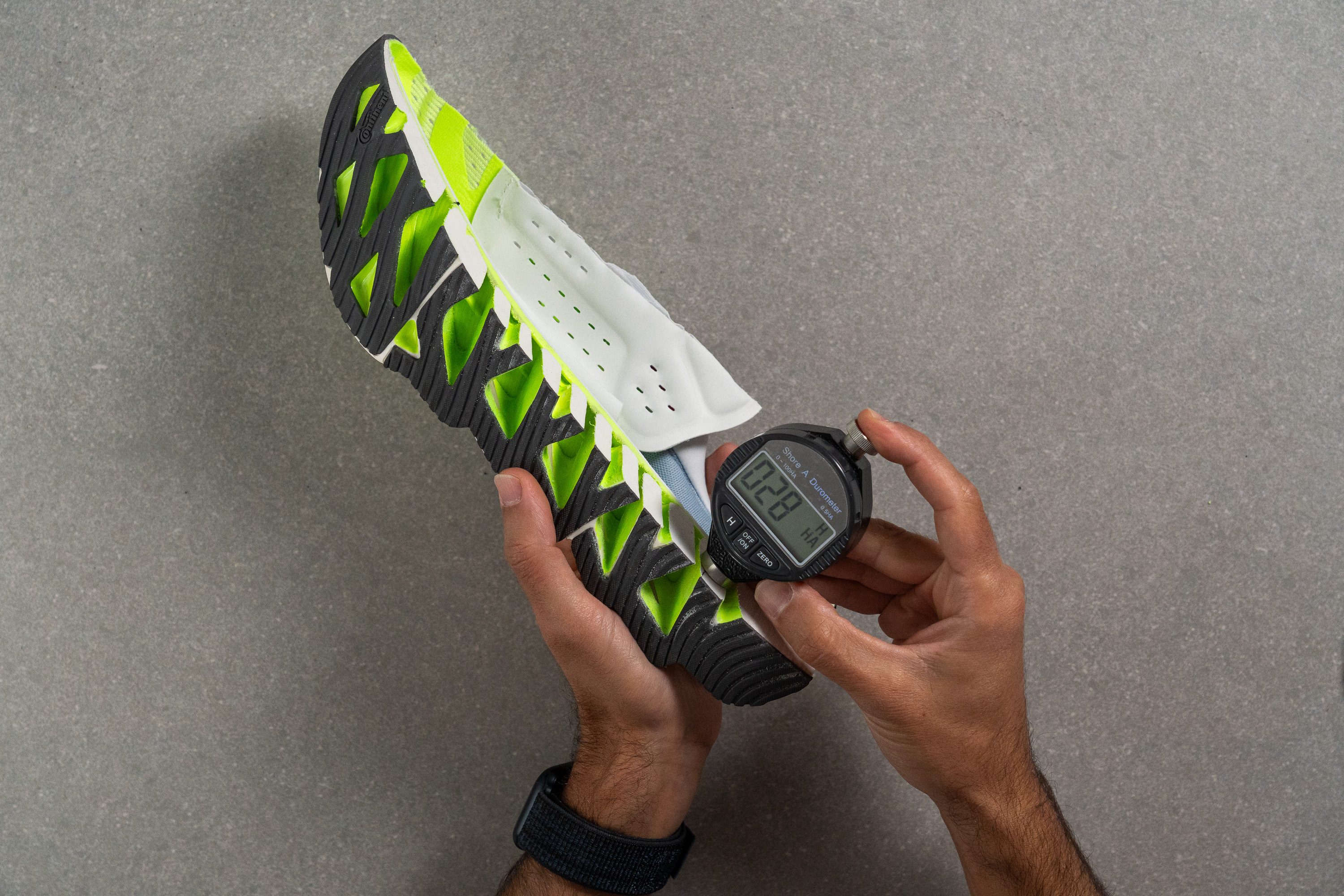
In configuring the midsole, Adidas seems to have looked at On Cloud shoes like the CloudSurfer 7 and said, “Hold my beer”, then came up with their own same-same-but-different solution. The angled grooves and cutouts that give the shoe its distinctive look also serve to accentuate the midsole cushioning, as it’s not just the foam but how the whole midsole compresses under our weight that cushions our landings.
As a result, the shoe feels much more plush underfoot than our durometer would lead us to believe.
Furthermore, the firmness of the foam means that the midsole quickly snaps back to shape as we shift our weight; giving the shoe a surprisingly responsive ride. By no means are we going to be smashing any PRs in this Switch FWD, but it’s definitely a fun jogging shoe and puts a nice spring in our step as we walk around town.
| Switch FWD | 27.3 HA |
| Average | 20.4 HA |
Size and fit
Size
Adidas Switch FWD fits true to size (17 votes).
Width / Fit
At 100.2 mm wide at its widest point according to our caliper measurements, the Switch FWD’s toebox is roomier than our current lab average. This makes the shoe accommodating for runners with wide feet without being too broad for their narrow-footed counterparts.
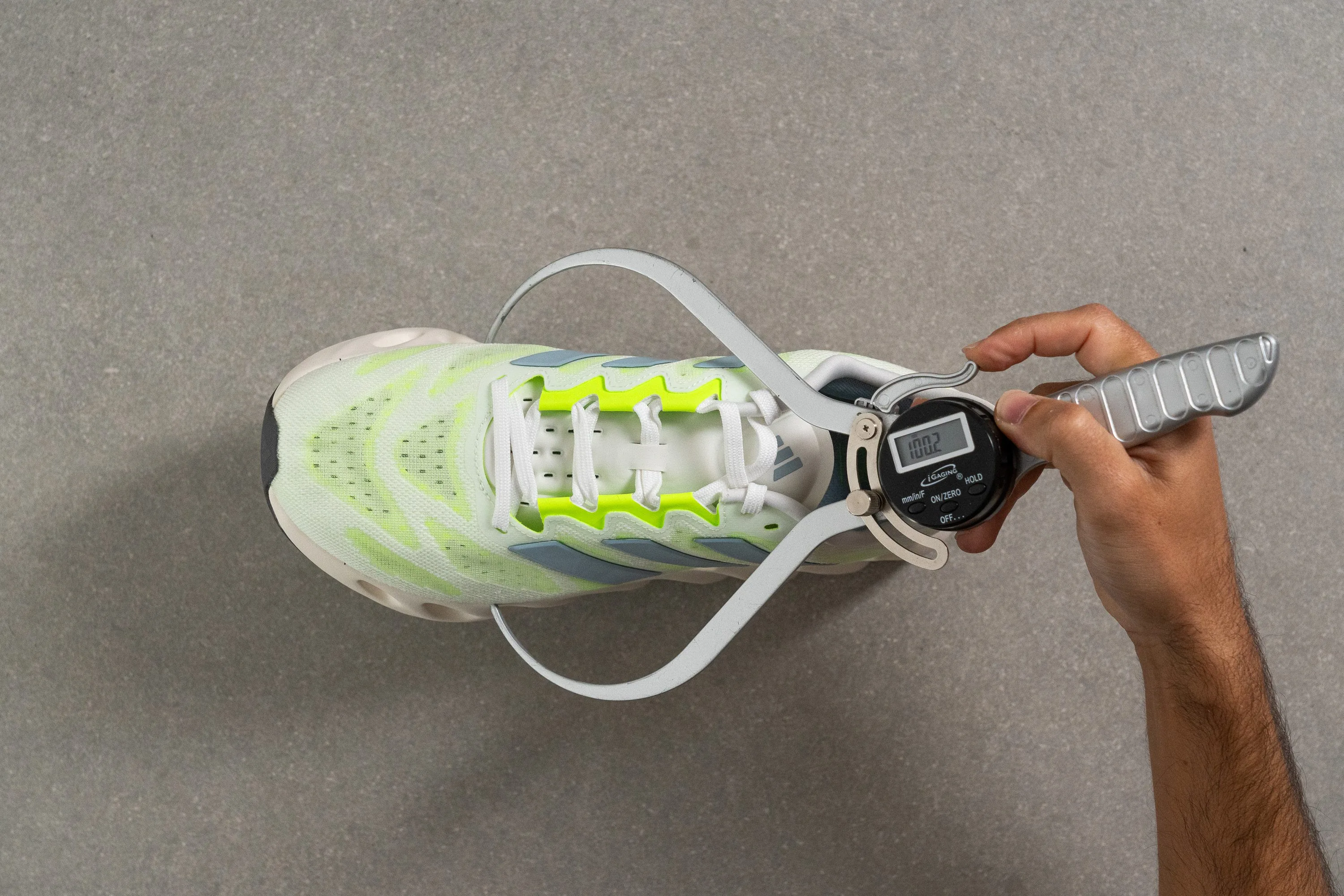
This test follows an older methodology, which is why you don't see recently tested shoes in the chart. Results from different methodologies can not be compared.
| Switch FWD | 100.2 mm |
| Average | 98.5 mm |
Toebox width
Moving up to the area around the big toe, we measured the toebox at 90.5 mm wide, which is within range of our current lab average. While this means that most runners should have enough room to splay out comfortably, the aggressive taper means that those with very broad feet or certain foot shapes might experience hotspots in this shoe.
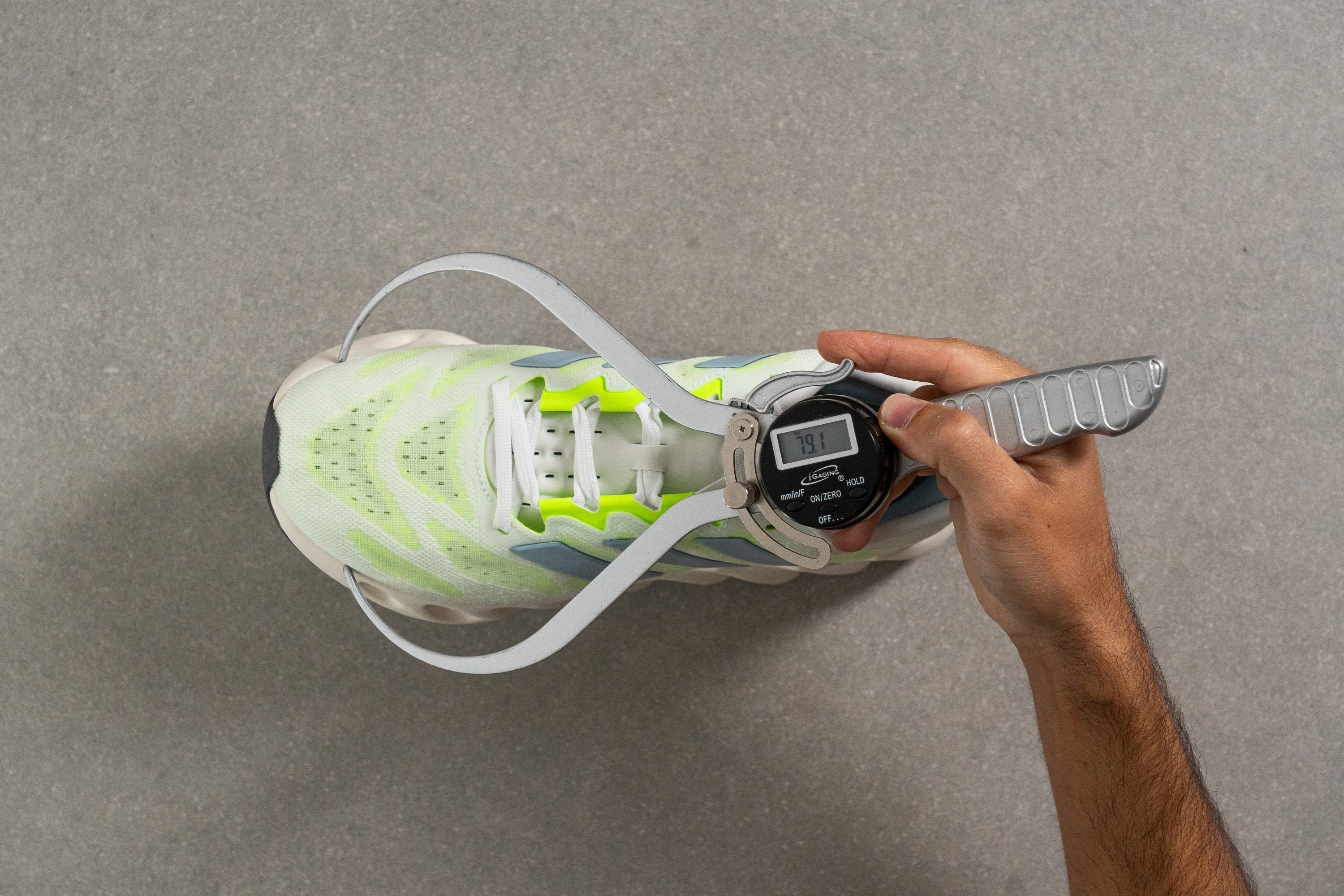
Check out this guide for choosing the right toebox for a comprehensive look at how the shape of our shoe in relation to our foot affects the quality of our runs.
This test follows an older methodology, which is why you don't see recently tested shoes in the chart. Results from different methodologies can not be compared.
| Switch FWD | 79.1 mm |
| Average | 78.4 mm |
Flexibility / Stiffness
We secured the Switch FWD to our workbench and found that 25.8N of force is required to bend the shoe 90 degrees in our flex test. This is a little less stiff than the average road shoe and means that the Switch FWD is able to bend along with our foot with relative ease. As a result, we found the ride to be quite forgiving during our test runs, with the shoe also feeling comfortable enough for all-day wear.
This test follows an older methodology, which is why you don't see recently tested shoes in the chart. Results from different methodologies can not be compared.
| Switch FWD | 25.8N |
| Average | 28.1N |
Stiffness in cold (%)
We also repeated the stiffness test after letting the Switch FWD chill in the freezer for twenty minutes, this time finding that 31.1N of force is needed to bend the shoe to the desired point. This is much more flexible than average under similar conditions, and actually puts the Switch FWD more on par with the average road shoe at room temperature! Therefore, this shoe should feel just as comfy and easy on the foot during the harsh winters as in the summer.
Becoming only 20.6% stiffer in the cold, the Switch FWD performs much better than the average road shoe in this test.
| Switch FWD | 21% |
| Average | 33% |
Weight
Despite all the cutouts in the shoe’s midsole and outsole, the Switch FWD is as chunky on the scale as it looks. Weighing in at 11.4 oz (323g), it’s significantly heavier than the average road shoe. As such, it’s not geared toward higher-intensity runs or long distances where weight affects performance.
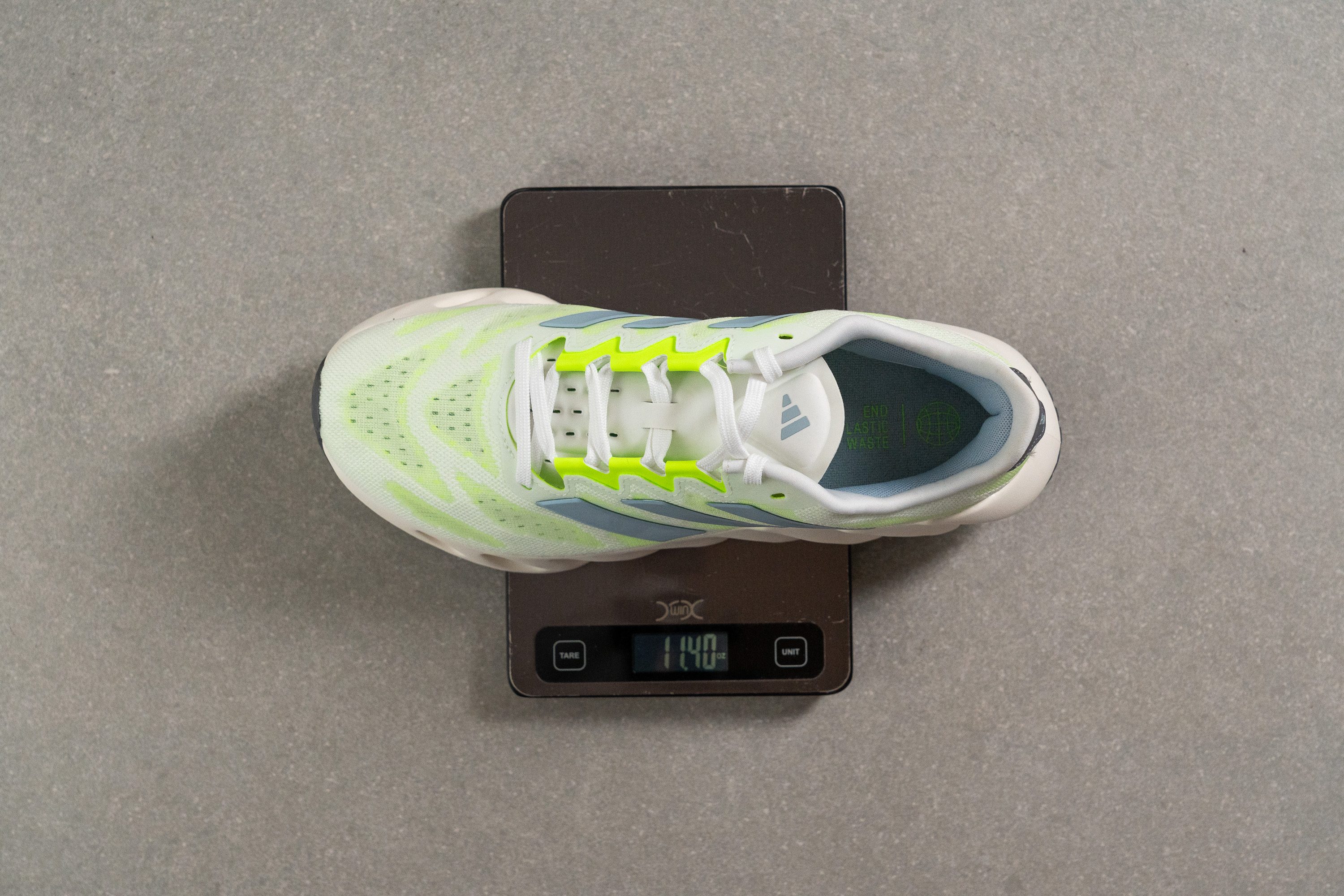
However, the spring in our step courtesy of the Switch FWD’s bouncy midsole means that the shoe doesn’t feel too burdensome when strutting around town or getting some cardio in with an easy jog.
| Switch FWD | 11.4 oz (323g) |
| Average | 9.3 oz (264g) |
Breathability
We pumped the Switch FWD full of smoke to get an idea of how breathable it is. As we can clearly see from the footage, the smoke filters out of the shoe quickly and with relative ease, with the only section that seems to choke up the smoke being the tongue. This above-average performance leads us to give the shoe a score of 4 out of 5, making it a good choice for warm summer days.
Inspecting a cross-section of the upper over a light source illuminates the shoe’s well-ventilated nature as the light easily shines through the porous mesh.
Our close-up images of the mesh reveal just how porous it really is. Made up of many fine, translucent fibres woven to form loose braids dotted with unreinforced perforated sections, it’s easy to see where all that airflow is coming from!
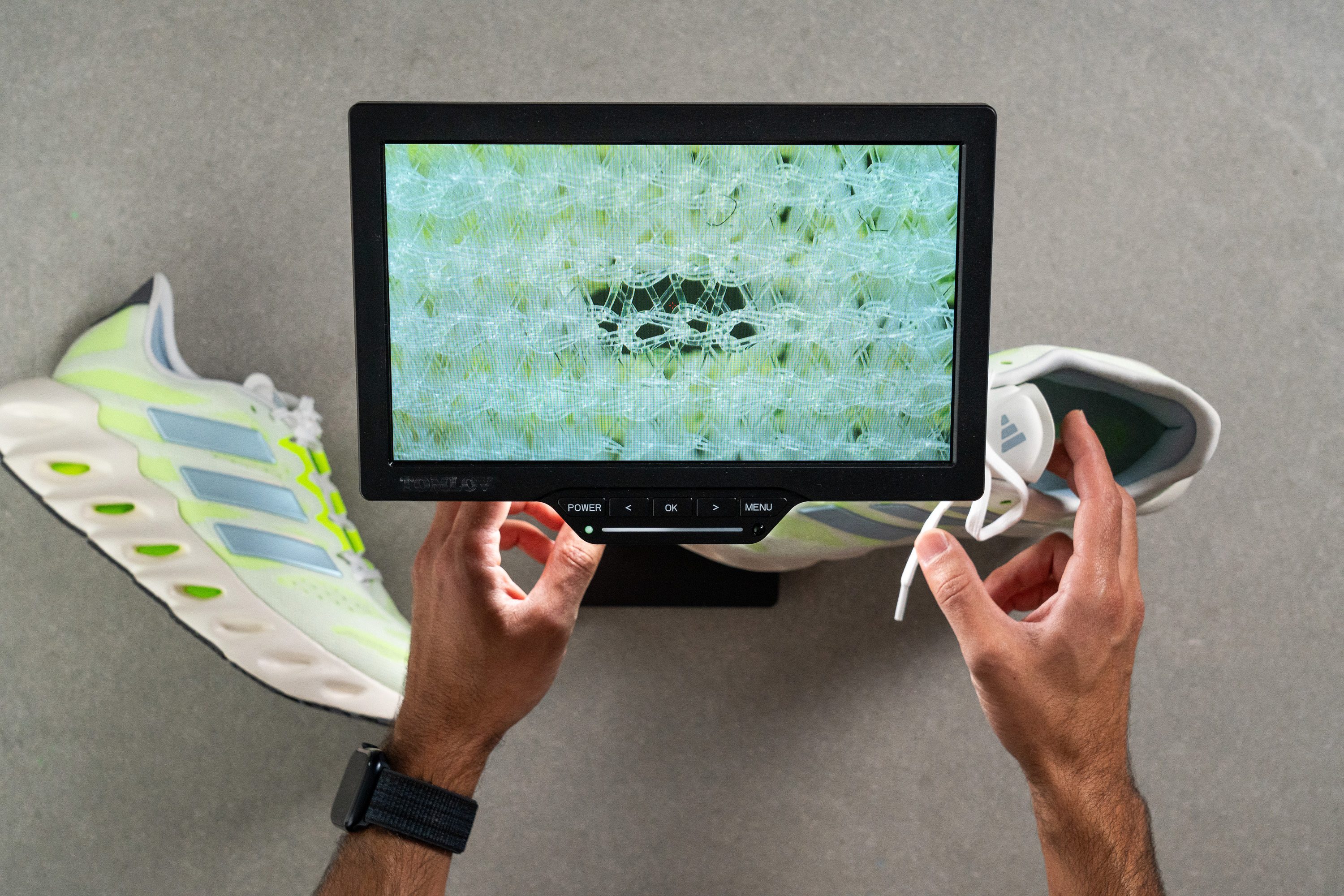
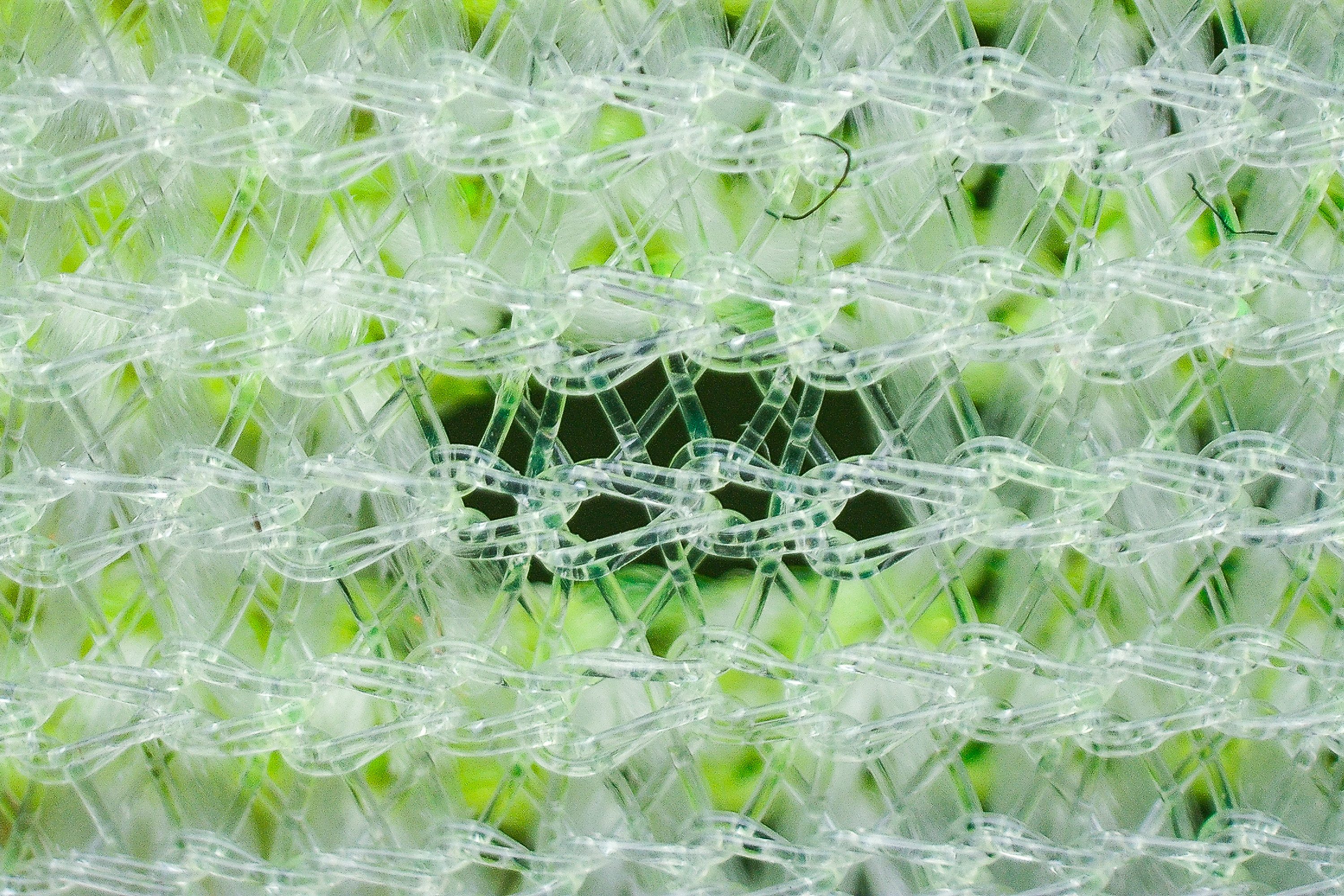
| Switch FWD | 4 |
| Average | 3.7 |
Stability
Lateral stability test
For a shoe on such a lofty stack, the Switch FWD didn’t feel as unstable underfoot as we expected when shifting our weight from side to side. This is thanks to the raised sidewalls at the rearfoot that allow our foot to be encompassed by the midsole rather than perched precariously atop it.
While this should be fine for those with mildly pronating strides, we recommend that runners with severe overpronation look into a stability shoe like the Hoka Gaviota 5 as a more supportive option.
Torsional rigidity
We were met with an above-average level of resistance as we attempted to bend and twist the shoe in our hands, leading us to give the Switch FWD a score of 4 out of 5 for torsional rigidity. This is thanks to the TPU plate above the midsole which prevents the shoe from contorting laterally, thus giving us a nice and level landing surface that promotes an overall stable ride.
| Switch FWD | 4 |
| Average | 3.5 |
Heel counter stiffness
The Switch FWD’s heel counter has some structure to it, making it feel somewhat rigid as we pinched and squeezed at it, earning it a middle-of-the-road score of 3 out of 5. This is good for a daily trainer as it comfortably holds the heel in place without putting too much pressure on our tendons.
| Switch FWD | 3 |
| Average | 2.9 |
Midsole width - forefoot
A wide base is key when it comes to stability and the Switch FWD’s midsole bears that out. At 120.3 mm wide at the forefoot, it’s much broader than average which gives us a nice and robust platform for steady forefoot landings and surefooted toe-offs.
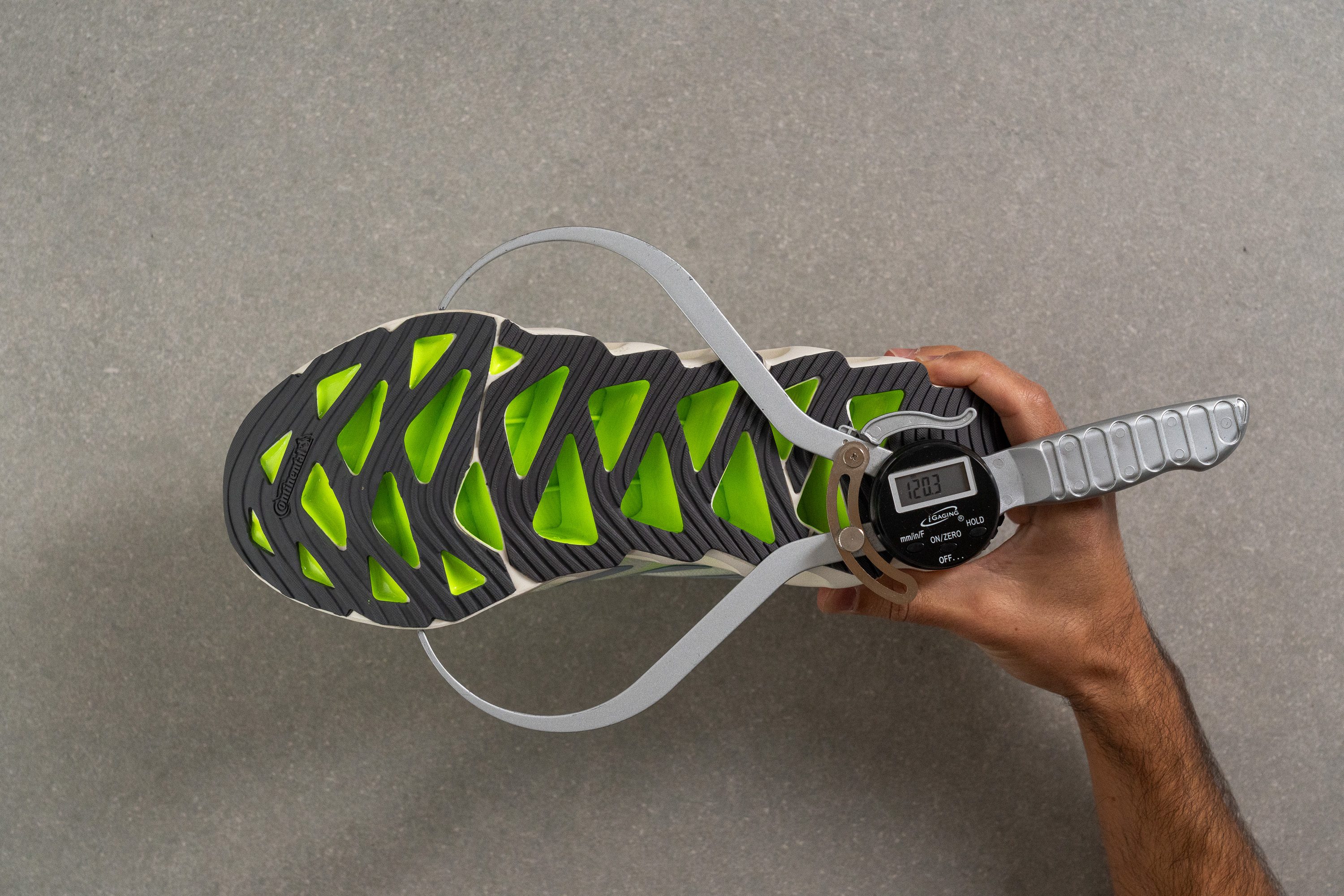
| Switch FWD | 120.3 mm |
| Average | 114.4 mm |
Midsole width - heel
The midsole isn’t quite as robust at the heel, measuring 90.5 mm wide according to our caliper. However, this is still on par with our current lab average, which means that heel strikers should also enjoy stable landings in this shoe.
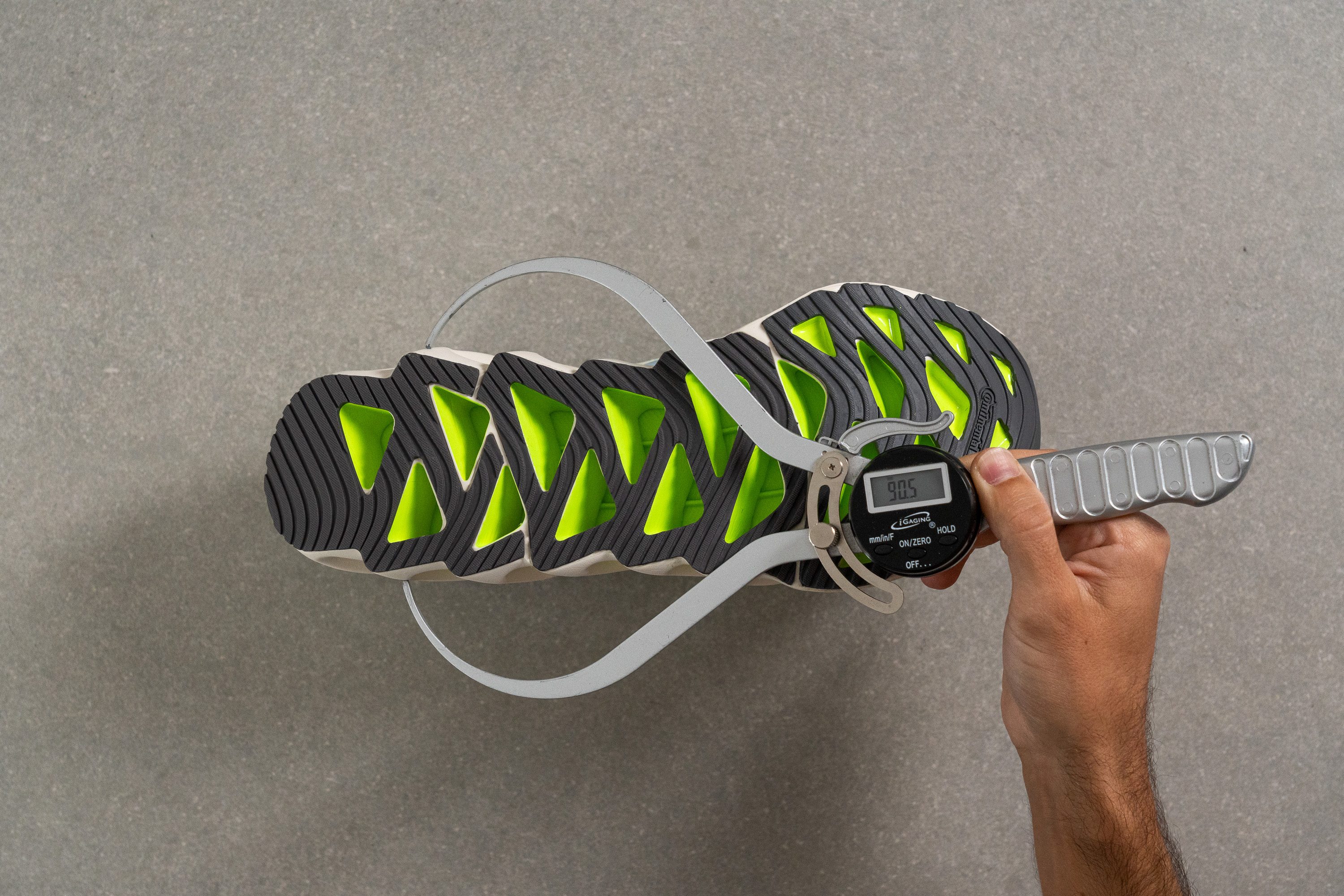
The midsole’s dramatic taper from forefoot to heel also lends the Switch FWD an attractive, aerodynamic silhouette that suits the badass design.
| Switch FWD | 90.5 mm |
| Average | 90.7 mm |
Durability
Toebox durability
First to face off against the dreadful Dremel in our battery of durability tests is the toebox. Applying the tool’s grinding element onto the mesh immediately sent specks of material flying hither and yon, with the debris being strangely dark despite the shoe’s light colorway.
Our Dremel had minced clean through the upper mesh by the end of the four-second test, leaving a massive hole in its wake. We therefore give the Switch FWD a toebox durability score of 1 out of 5.
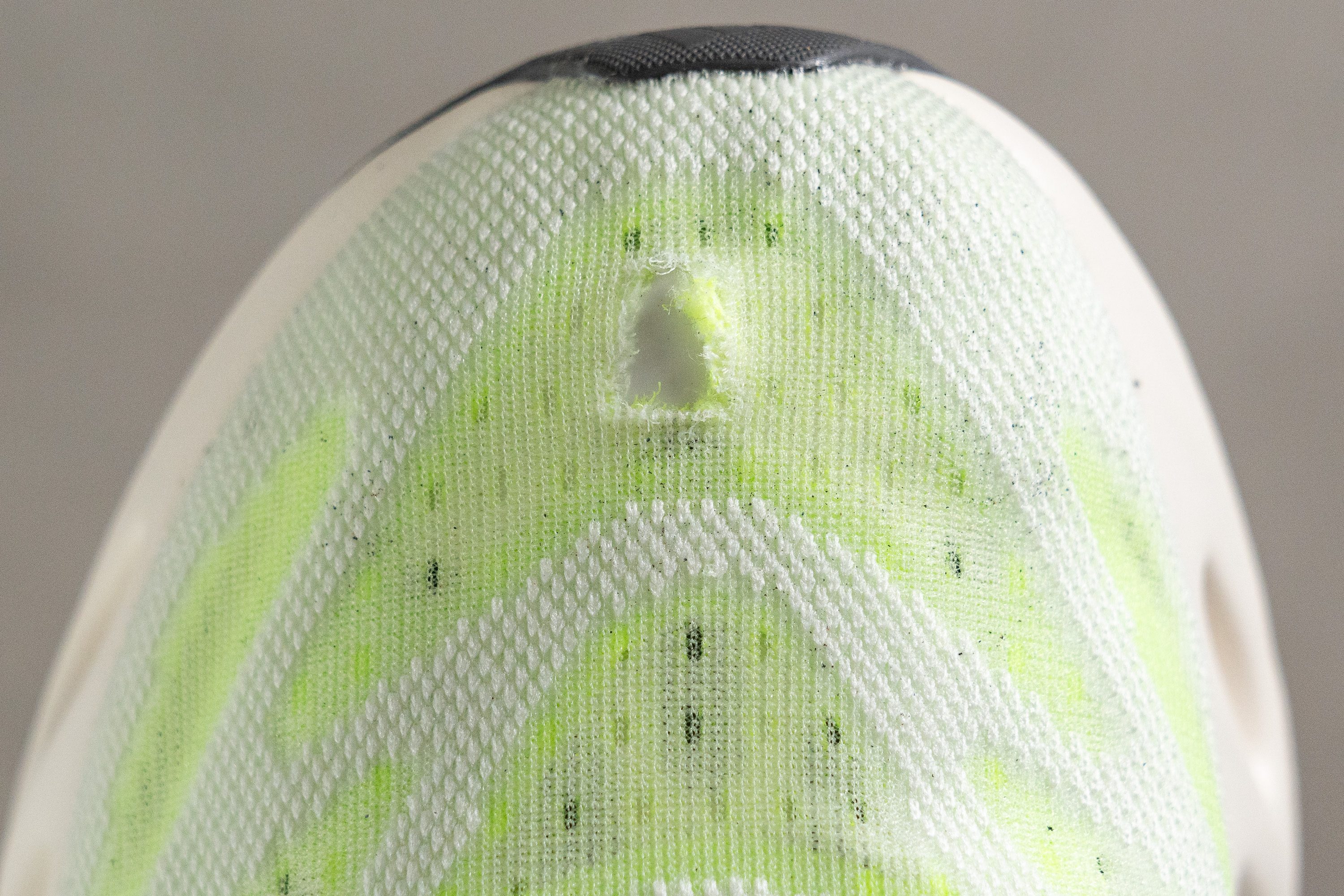
| Switch FWD | 1 |
| Average | 2.6 |
Heel padding durability
Next, we turned our attention to the heel counter and fired up our Dremel once more, and again the tool seemed to deal a lot of damage right from the onset.
However, upon assessing the damage once the four seconds were up, we found that we had only frayed the mesh lining and made a bit of a mess while the soft padding remained intact. This excellent performance earns the shoe a 4 out of 5 for heel padding durability.
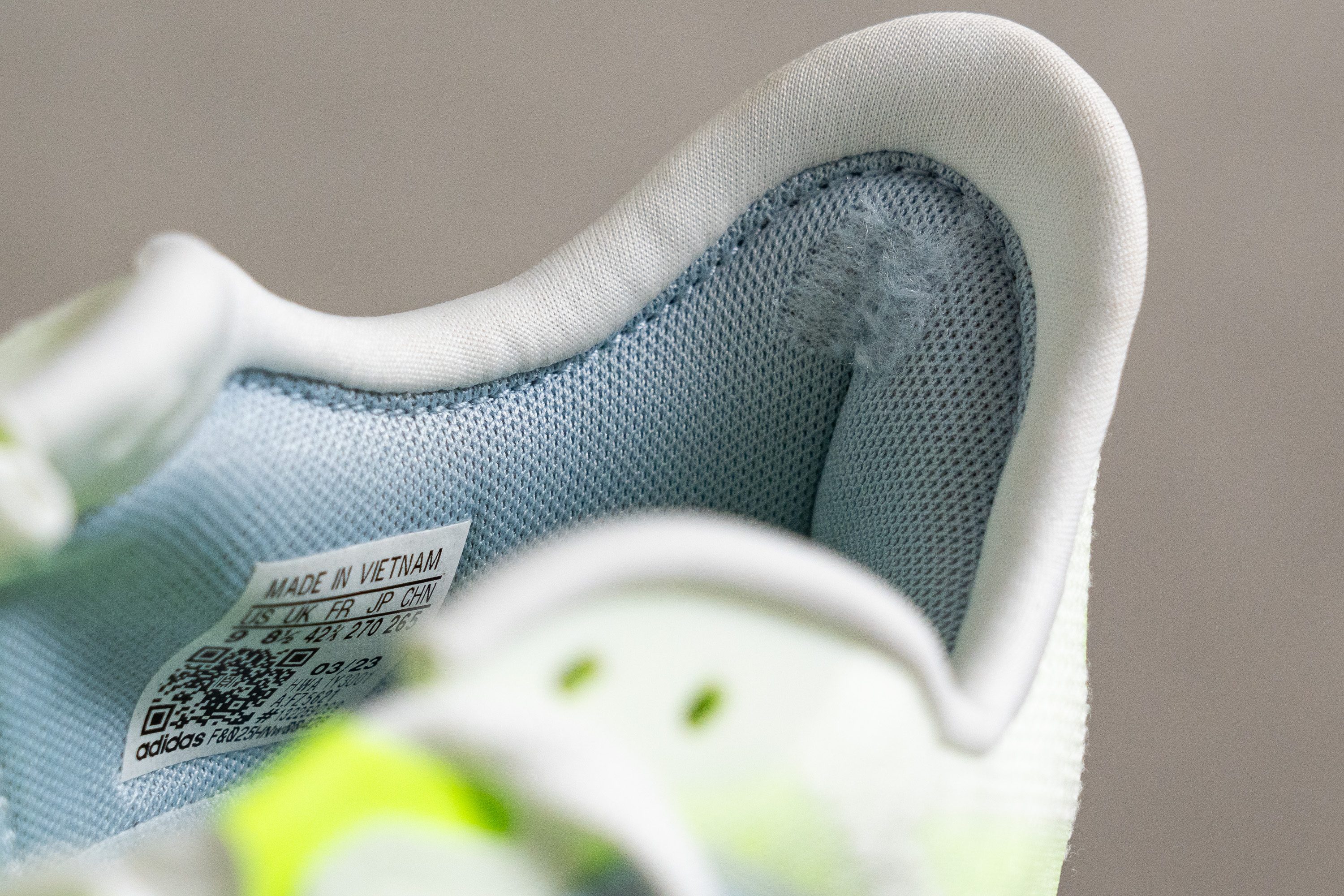
| Switch FWD | 4 |
| Average | 3.4 |
Outsole hardness
Pressing our durometer against the Switch FWD’s outsole yields a significantly higher-than-average reading of 86.6 HC. This puts the outsole more on par with those found on trail shoes; a fact that bodes well for its hardiness.
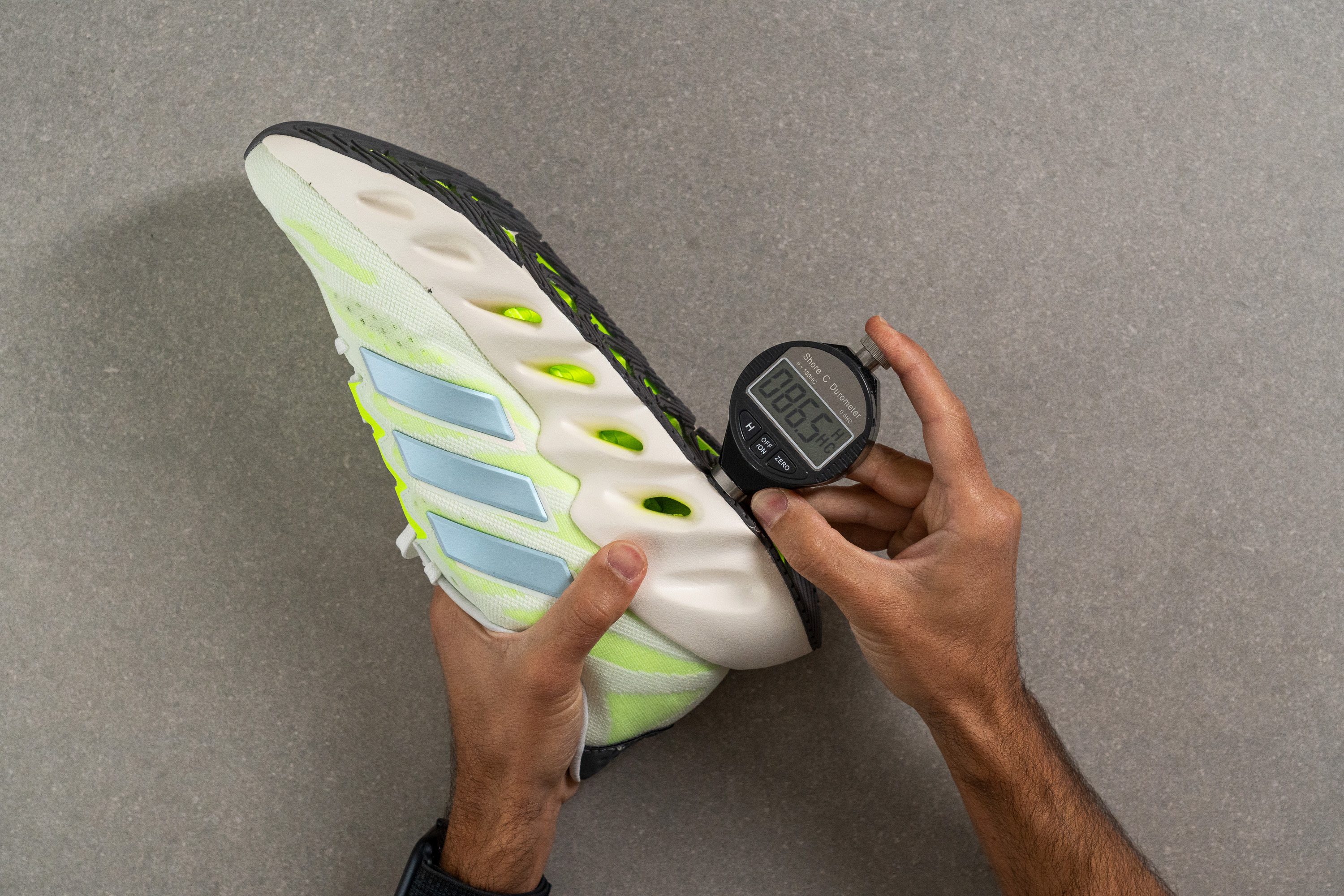
| Switch FWD | 86.6 HC |
| Average | 79.2 HC |
Outsole durability
Our assumption was borne out by firing up the Dremel one last time. This time spinning at 10K RPM for twenty seconds, the tool’s grinding element was barely able to bite into the rubber for some time. Eventually, a small mist of fine particles is kicked up but the test goes by rather smoothly.
Once the Dremel was powered down, we found that we had only lopped off 0.58 mm of rubber from the outsole. This is much less than the average road shoe loses in this test, making the Switch FWD’s outsole impressively durable.
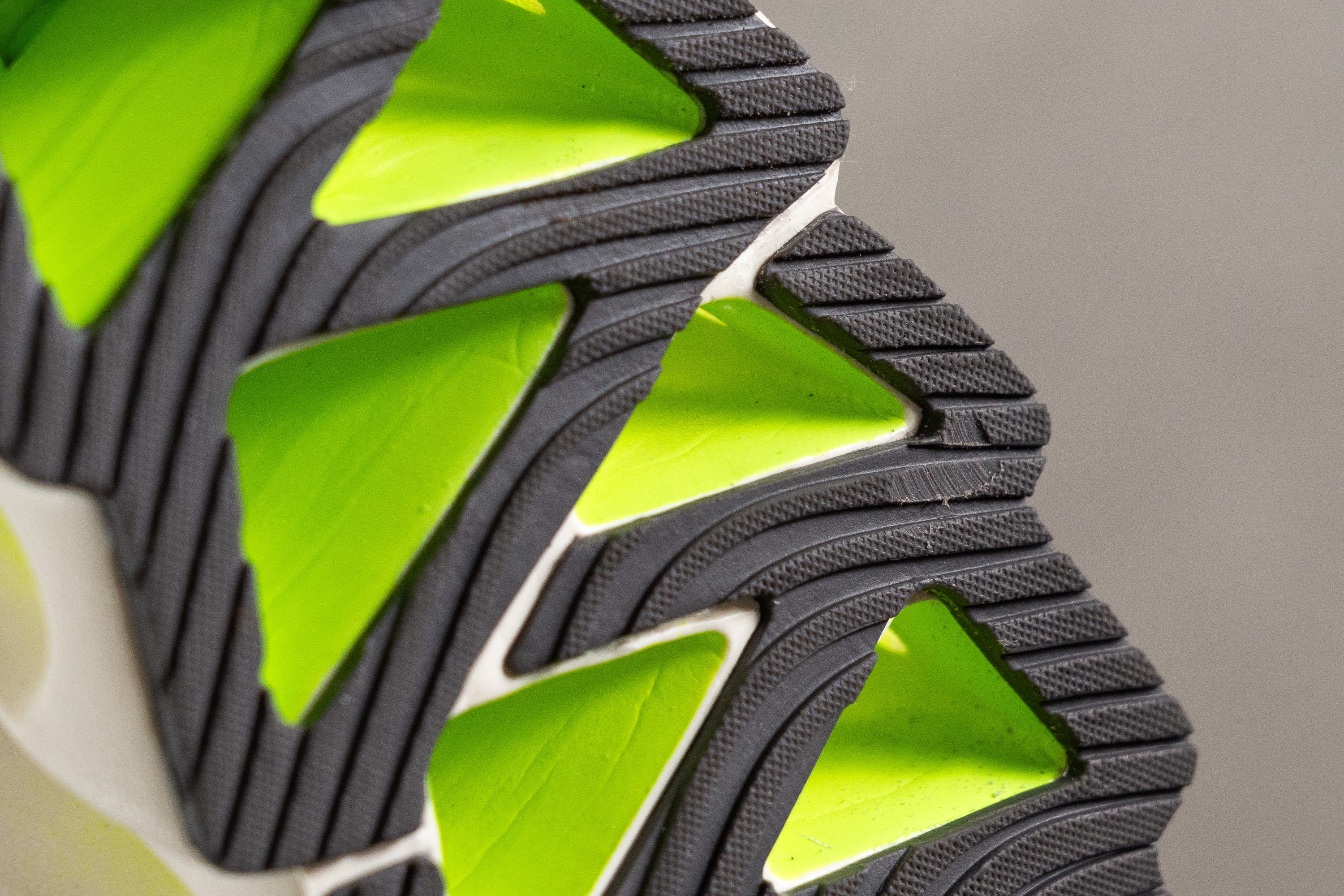
| Switch FWD | 0.6 mm |
| Average | 1.1 mm |
Outsole thickness
At 3.3 mm thick according to our caliper measurements, the Switch FWD’s outsole is right on par with our current lab average. Although, with the performance of the outsole in our previous test, we think this is one area Adidas could have skimped on material and shaved some much-needed weight off this shoe.
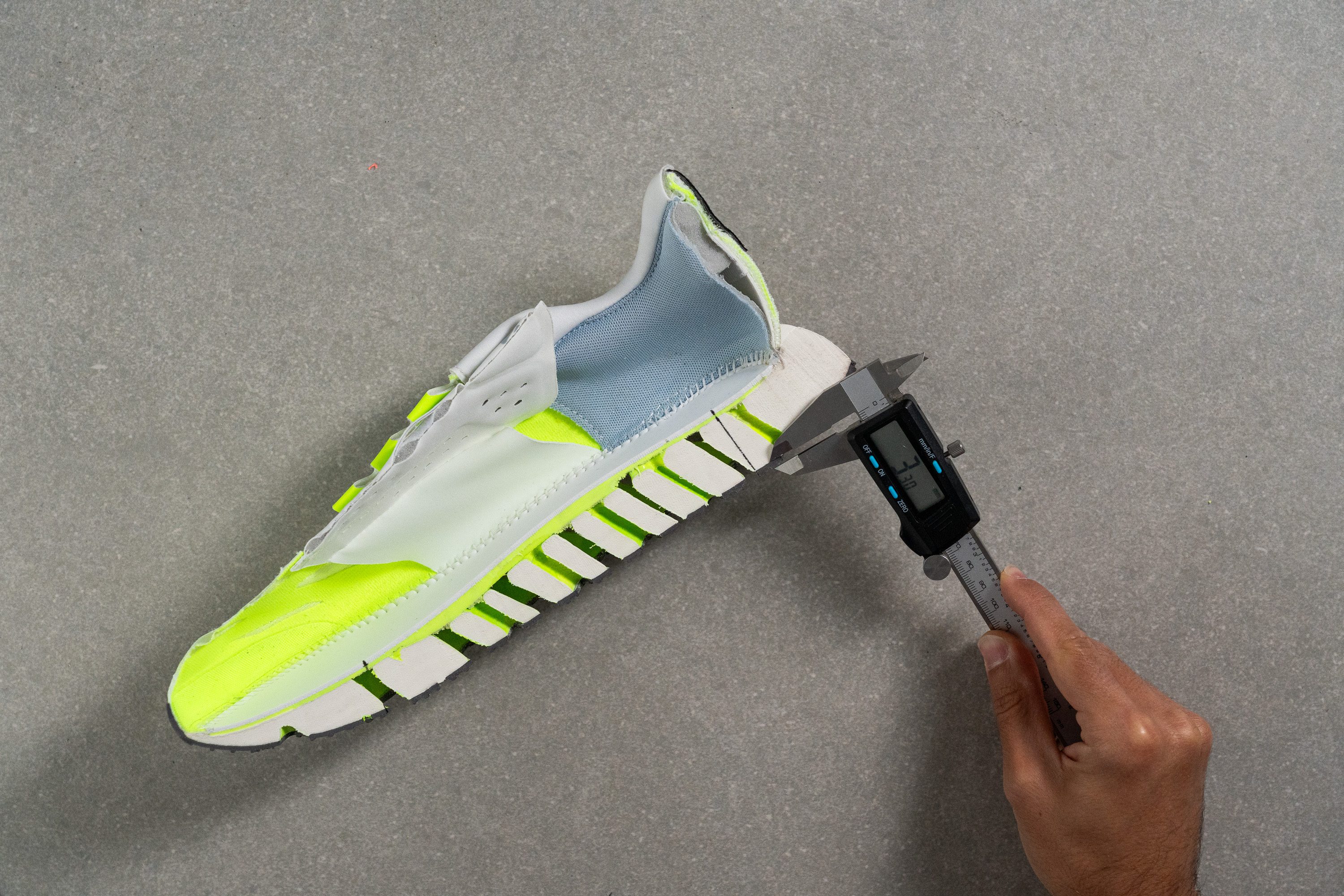
| Switch FWD | 3.3 mm |
| Average | 3.2 mm |
Misc
Insole thickness
At 5.2 mm thick, the Switch FWD’s insole is thicker than our current lab average; giving us a plush surface within the shoe which, in conjunction with the midsole, serves to pamper our feet as we move around.
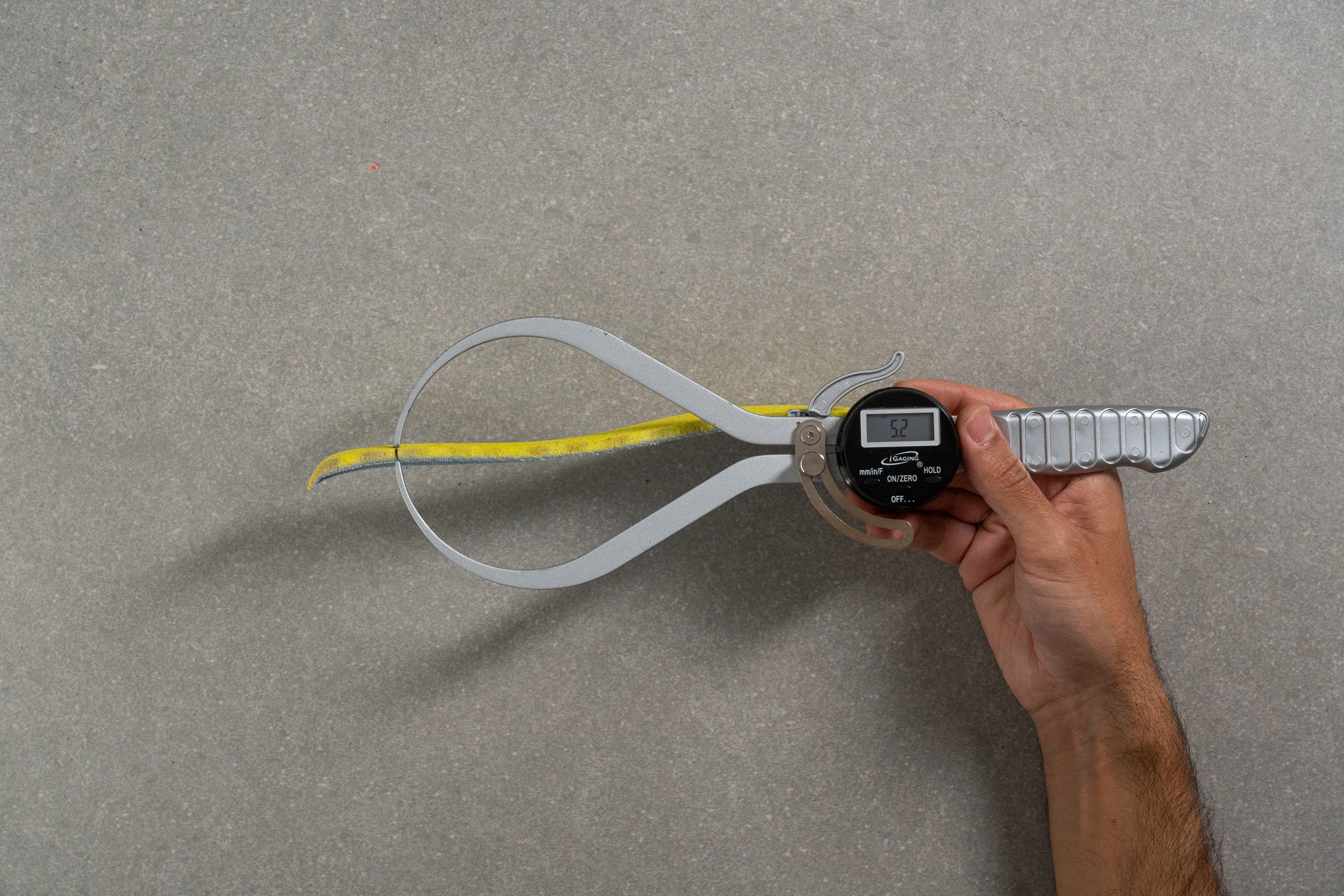
| Switch FWD | 5.2 mm |
| Average | 4.5 mm |
Removable insole
Runners in need of custom orthotics will be able to replace the existing insole with ease as it’s not glued in.
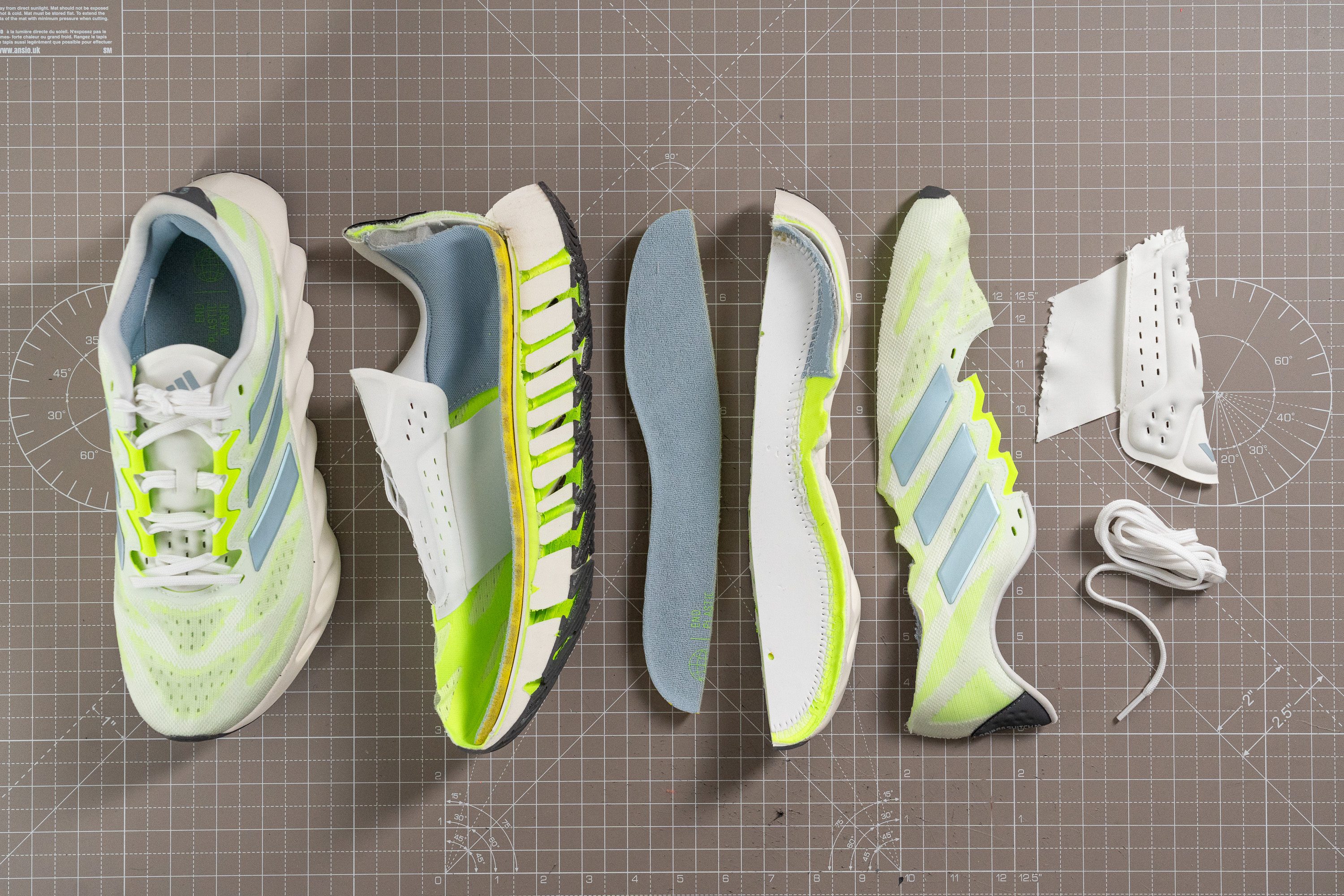
| Switch FWD | Yes |
Midsole softness in cold (%)
After placing the Switch FWD in the freezer for twenty minutes, we took another durometer reading of the midsole to see the effects of cold conditions on it. With a result of 35.5 HA, the Switch FWD’s midsole is firmer than the average road shoe’s under similar conditions. However, with the configuration of the midsole providing a bulk of the cushioning, we expect the shoe to still effectively dampen impact during winter runs.
With a 30.3% increase in firmness, the Switch FWD’s midsole is slightly less consistent than average between warm and cold conditions.
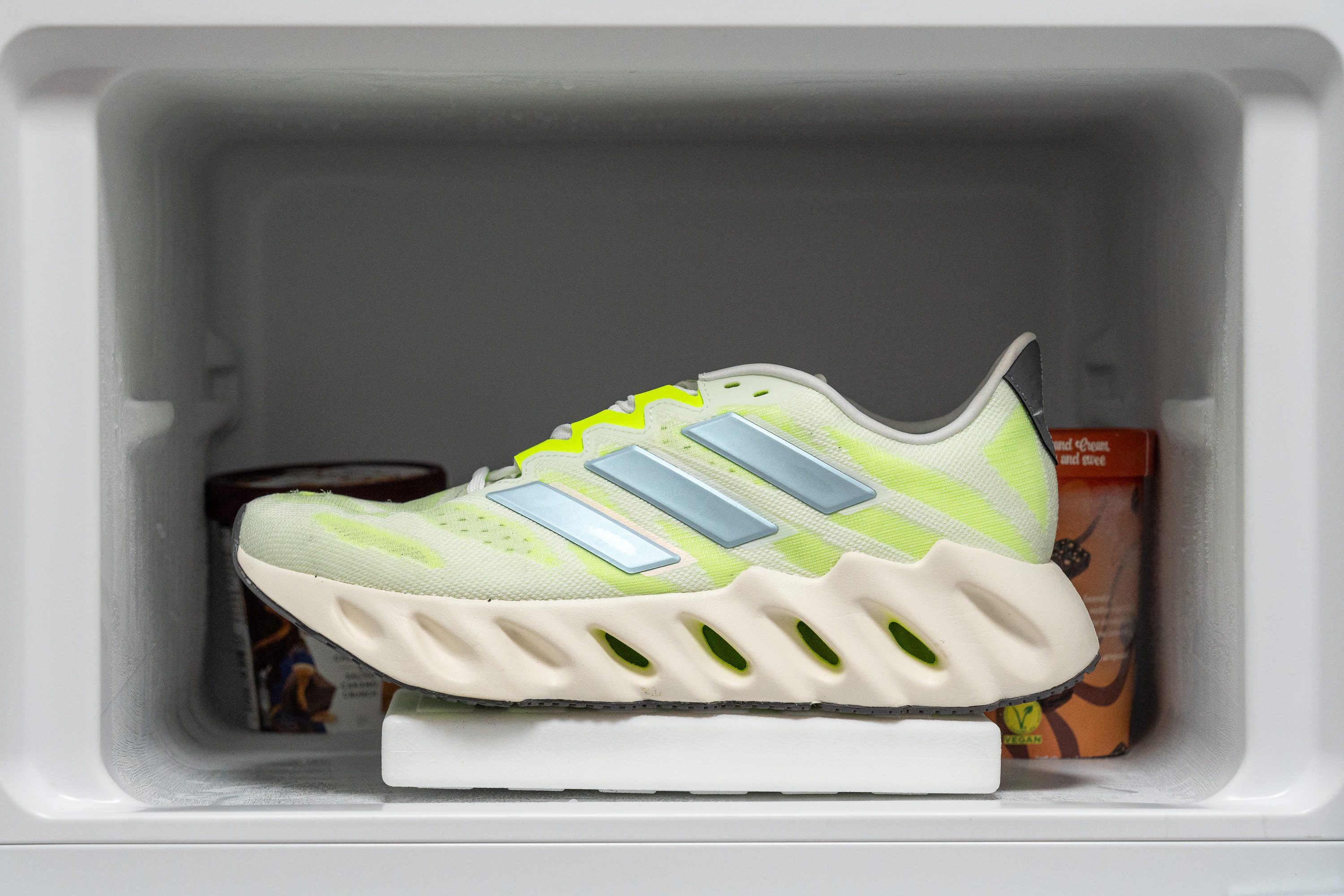
| Switch FWD | 30% |
| Average | 24% |
Reflective elements
With no reflective elements to speak of, we recommend using additional high-vis gear and sticking to well-lit routes if going for a nocturnal session in the Switch FWD.

| Switch FWD | No |
Tongue padding
Using our caliper, we found the tongue to be just shy of our current lab average at 5 mm thick. However, we still enjoyed lots of comfort around the instep, with the somewhat firm padding strategically placed to ward off any sensation of lace bite.
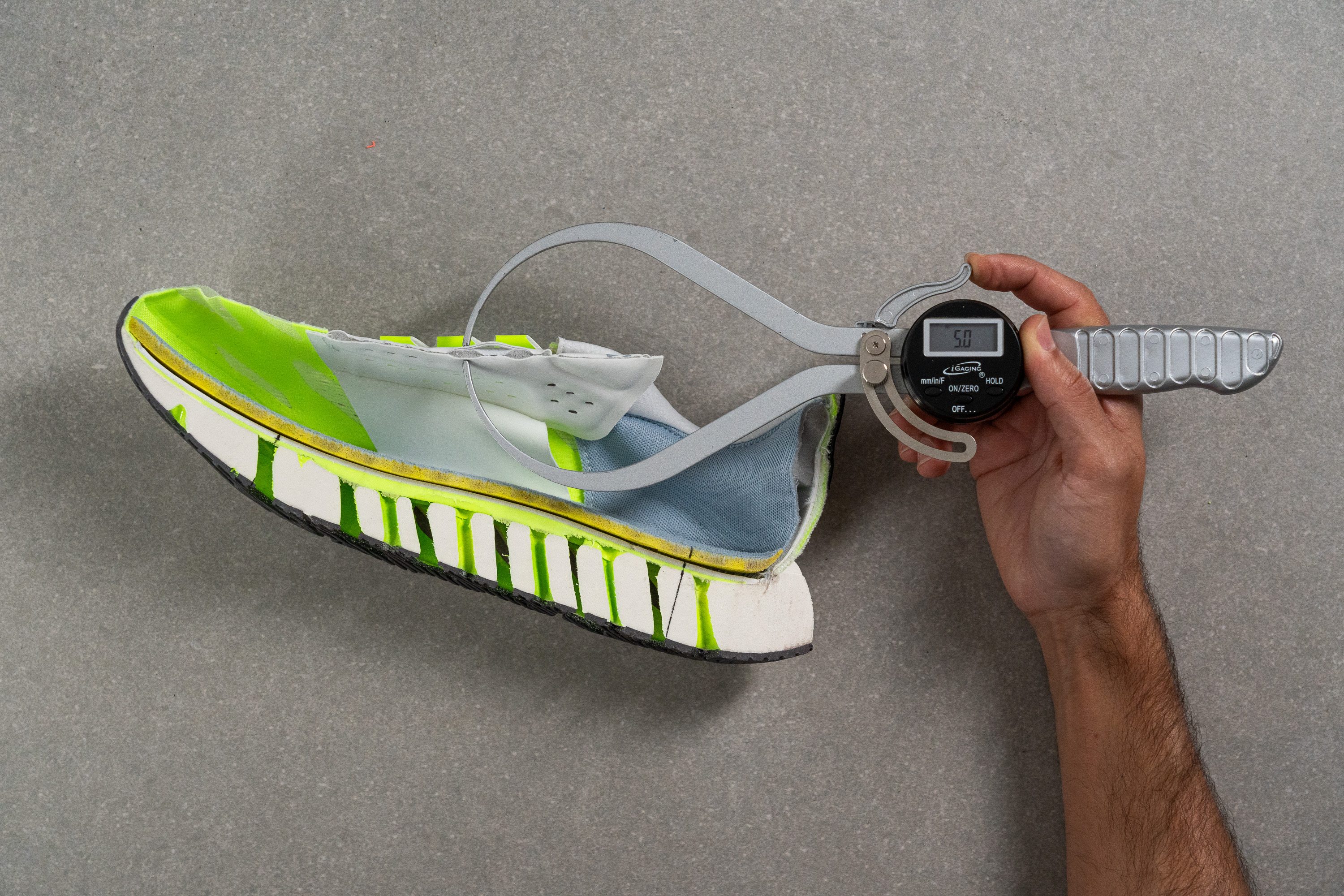
| Switch FWD | 5.0 mm |
| Average | 5.8 mm |
Tongue: gusset type
The tongue is semi-gusseted on both sides with rather long elastic straps that do a good job keeping that sucker from shifting from side to side as we move around in the Switch FWD.
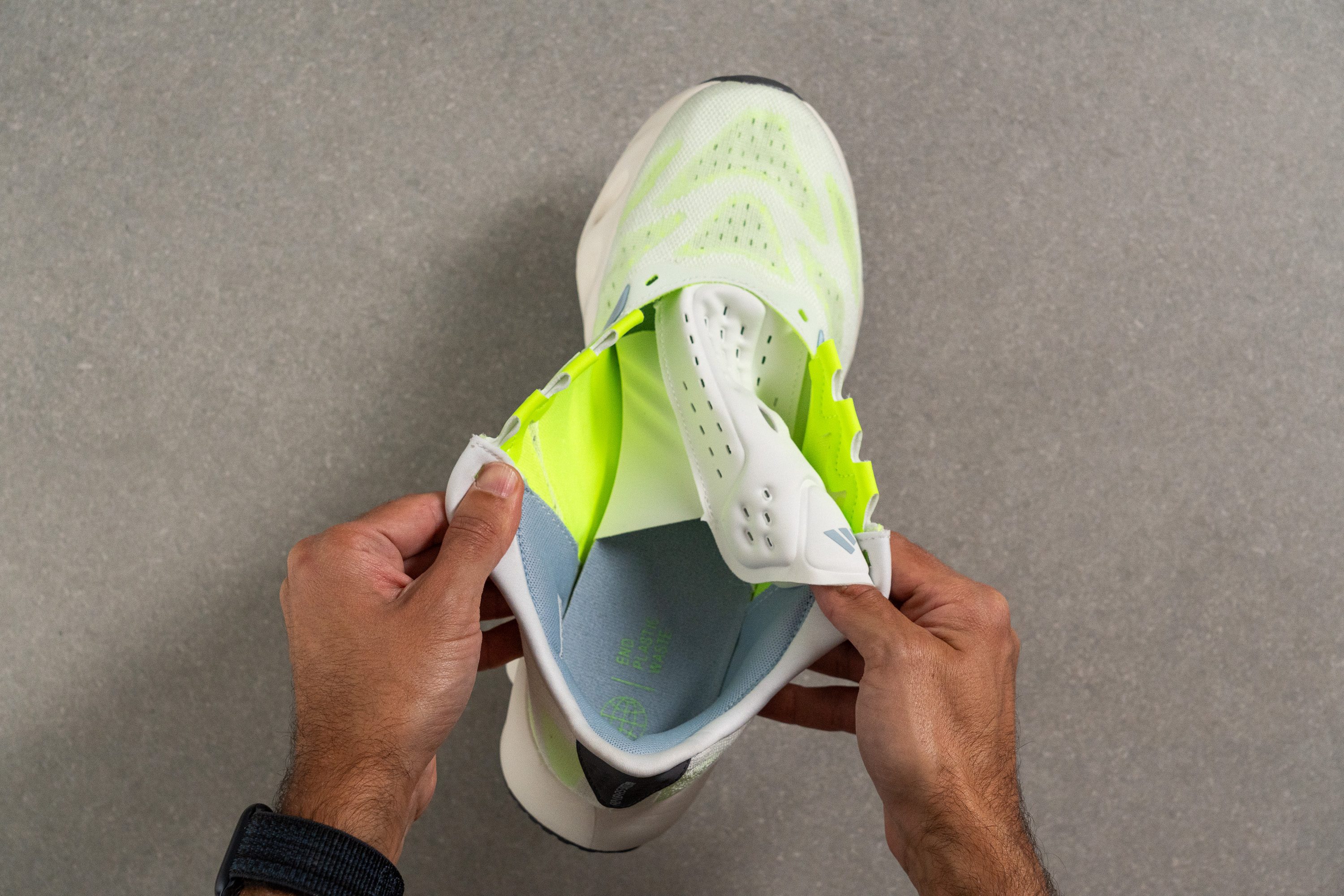
| Switch FWD | Both sides (semi) |
Heel tab
The Switch FWD doesn’t feature a traditional heel tab, but the heel counter itself flares up into an elf-ear kind of shape that makes sliding the shoe on and off a breeze.
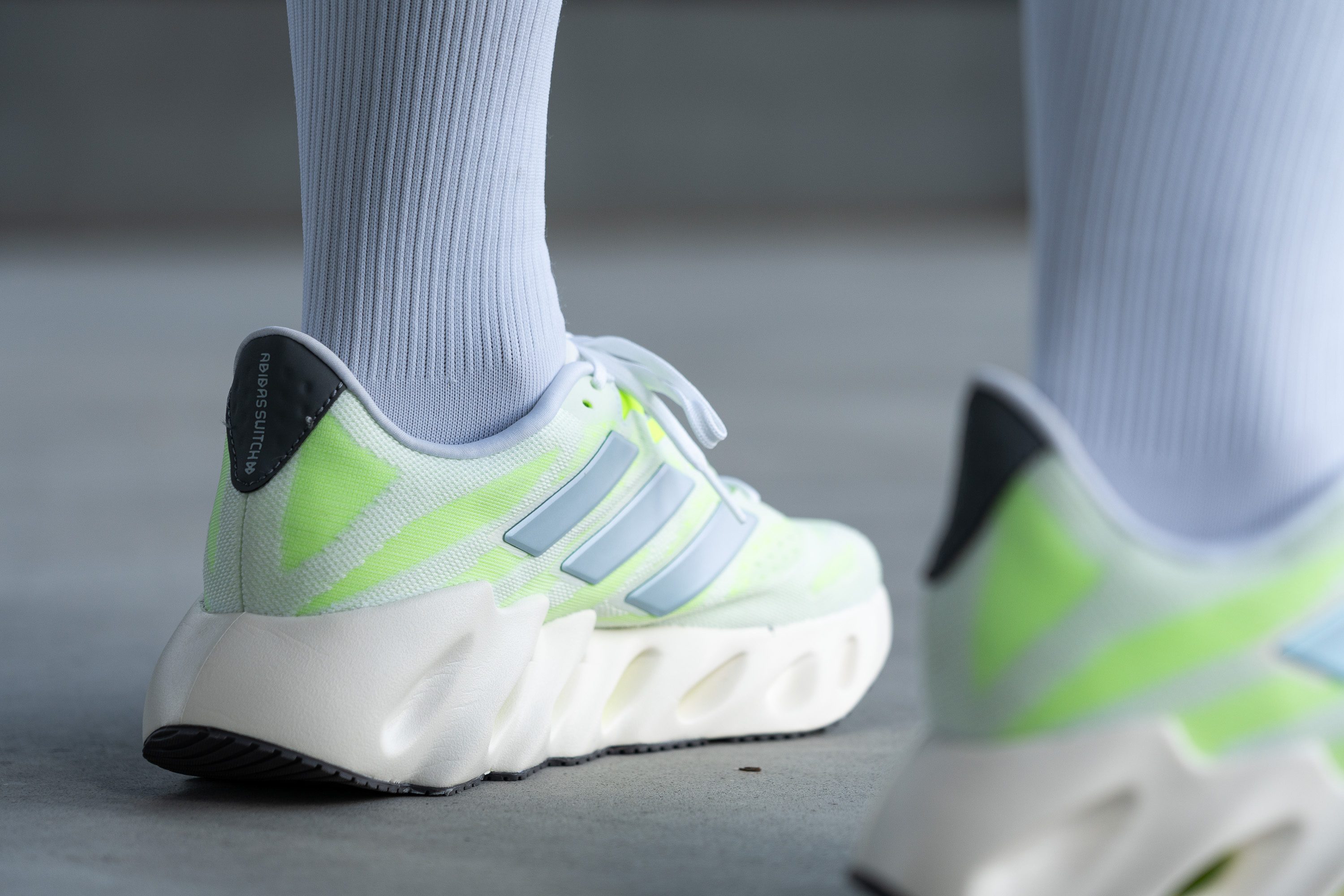
| Switch FWD | None |

